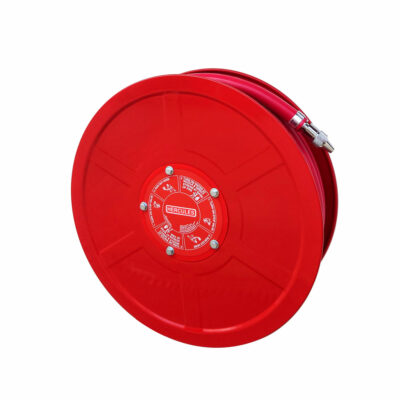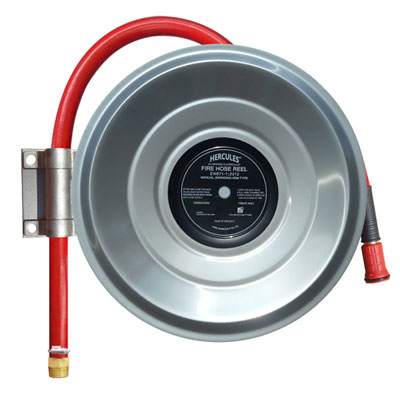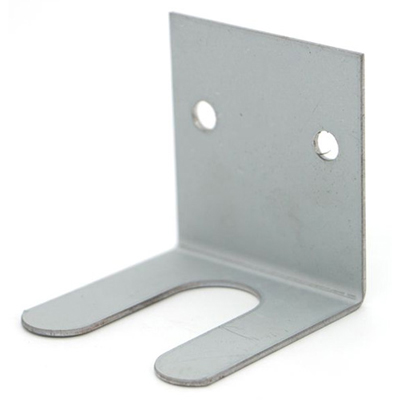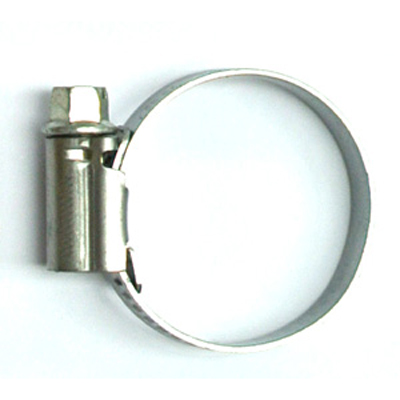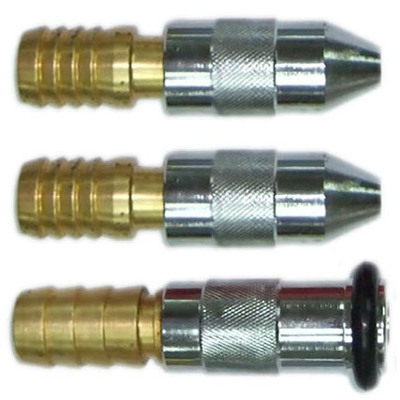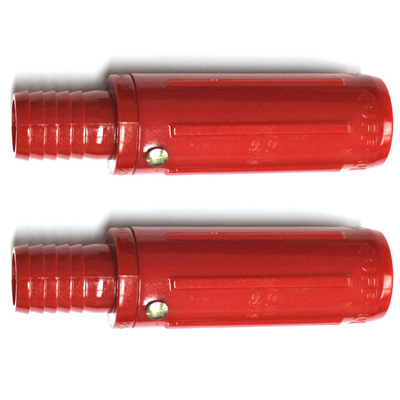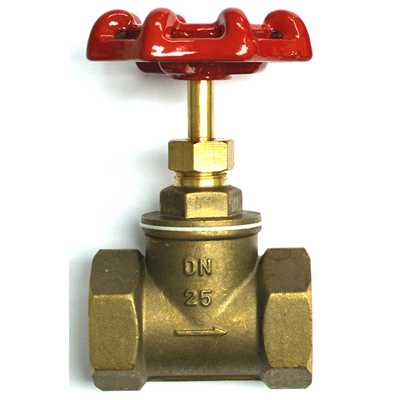Fire Hose Reel
Fire hose reels are located to provide a reasonably accessible and controlled supply of water to combat a potential fire risk. The length of a fully extended fire hose is 30 metres. With the hose fully extended, a first responder can easily fight larger fires at a safer distance. With an unlimited water supply, there is a larger margin of error allowed. The downside is that fire hose reels are installed in a fixed location and the 30m of hose can be quite heavy to drag and set up for fire fighting efforts.
In addition, a control nozzle attached to the end of the hose enables the operator to control the direction and flow of water to the fire. All fire hose reels come with a unique ball valve shut-off device, a plastic or solid brass hose reel nozzle and a mounting bracket.
It is not uncommon to see hose reels mounted in recessed walls. However, there should be visible hose reel signs indicating that there is a hose reel. The most common violation of the Singapore Fire Code is the storage of unauthorised objects. Unfortunately, cleaning tools are often stored in the same compartment of the fire hose reel. As a result, in times of emergency, the fire hose reel operator is unable to have easy access to the fire hose reel. This could lead to a delay in firefighting or rescue efforts.
Purpose of Fire Hose Reels
A fire hose reel is specifically designed to discharge water. The use of water is to cool down the temperature of the fire and bring it below the ignition point. As such, it can only put out class A fires. Class A fires involve common combustible materials such as wood, paper, fabric, and plastics. When these materials catch fire, a fire hose reel can quickly and efficiently douse the flames, providing an effective means of fire suppression. However, fire hose reels are not suitable for other classes of fires, such as Class B (flammable liquids) or Class C (electrical) fires, as the use of water in these instances can be ineffective or even hazardous. Therefore, it is crucial to understand the appropriate use of fire hose reels and employ them accordingly to ensure the safety of individuals and property.
Installing Fire Hose Reels
According to Singapore SCDF Fire Code chapter 6.2.8 (d),
(3) Hose reels shall be sited in prominent and accessible locations within a distance of 5m from the exit door but not inside exit staircases. If there are parts of the floor space that are beyond the 36m coverage (30m hose path and 6m throw) of the hose reel, additional hose reels shall be provided at the common area or at a distance of not more than 5m from the exit access door of a room.
Recommended locations for fire hose reel installation
- Near exits and escape routes: Place fire hose reels close to exit doors and escape routes to facilitate quick access during emergencies.
- High-risk areas: Install fire hose reels in areas prone to fire hazards, such as kitchens, electrical rooms, or areas with flammable materials.
- Large open spaces: Consider installing fire hose reels in large open spaces where fires can spread quickly, such as warehouses or storage facilities.
Tips and important points to note regarding fire hose reels
- Visibility and accessibility: Ensure that fire hose reels are easily visible and accessible, without any obstructions or obstacles in their path.
- Clear signage: Clearly label fire hose reel locations with appropriate signage to ensure they can be easily identified during emergencies.
- Regular inspections and maintenance: Conduct regular inspections and maintenance of fire hose reels to ensure they are in good working condition and ready for immediate use.
- Adequate training: Provide training to employees or occupants on how to operate fire hose reels effectively and safely.
- Compliance with regulations: Ensure that the installation and positioning of fire hose reels comply with local fire safety regulations and standards.
How to Use a Fire Hose Reel
- Turn on the water supply valve.
- Check if there is water
- Run out hose
- Discharge water from the nozzle from a safe distance
Compared to portable fire extinguishers, fire hose reels are significantly easier to operate. While it is easy to grab and go with a fire extinguisher, the total discharge duration is short. Subsequently, if the fire extinguisher does not put out the fire, it will quickly reignite to its original size. Ideally, if there are two first responders, one should begin setting up the fire hose reel while the other should head to the fire with a fire extinguisher. In this manner, if the fire extinguisher fails, the fire hose reel can quickly take over firefighting efforts.
How to Choose a Fire Hose Reel
When choosing a fire hose reel, you have two main types to consider: manual rewind and automatic rewind. Manual rewind reels require manual turning to rewind the hose, offering versatility and affordability. Automatic rewind reels use a spring-driven mechanism for convenient and quick hose retraction with the push of a button, ensuring safety and saving time.
Consider factors such as budget, convenience, application, and maintenance requirements to make the right choice for your needs.
How to Do Maintenance for Fire Hose Reels
Following Singapore Standards, fire hose reels have to be maintained annually by a trained technician. During maintenance, the technicians will check for leakages, kinked hoses or damaged drums which may impede firefighting efforts. Here are the other steps and best practices for the maintenance of fire hose reels:
- Test the hose reel: Activate the fire hose reel to ensure that it operates smoothly. Check the hose reel drum for proper rotation and ensure that the hose is deployed without any obstructions or tangling.
- Inspect hose condition: Examine the condition of the hose for any wear, tears, or signs of deterioration. Replace the hose if there are any significant damages that may compromise its integrity.
- Check nozzle functionality: Test the nozzle of the fire hose reel to ensure that it opens and closes properly and that it provides an adequate water flow. Look for any blockages or clogs that may hinder water delivery.
- Assess drum and mounting: Inspect the fire hose reel drum and its mounting brackets for any signs of damage or looseness. Ensure that the drum rotates smoothly and is securely mounted.
- Lubrication and corrosion prevention: Apply lubrication to moving parts as recommended by the manufacturer to ensure smooth operation. Protect the fire hose reel and fittings from corrosion by using appropriate anti-corrosion agents.
- Documentation: Keep detailed records of all maintenance activities, including dates, findings, repairs, and replacements. This documentation helps track the maintenance history of each fire hose reel and ensures compliance with regulations.
Why Choose Our Fire Hose Reels
Choose Fire Armour for your fire hose reel needs and benefit from our expertise and experience in the industry. We source high-quality fire hose reels, ensuring reliability and effectiveness. We aim to maintain stringent quality standards and incorporate innovative technologies. Our fire hose reels are built to last, with exceptional durability and advanced features. Trust Fire Armour for top-notch fire safety equipment such as fire hoses, CO2 fire extinguishers and others that exceeds expectations.
Certified Fire Hose Reels
At Fire Armour, we take pride in our certified fire hose reels that adhere to the highest safety standards. Our commitment to regulatory compliance and industry excellence is demonstrated through our certifications and involvement with the Singapore Standards discussion group.
We have actively participated in the Singapore Standards discussion group to establish the latest safety standards for fire extinguishers. This ensures that our fire hose reels meet or exceed the requirements set forth by industry regulations.
Safety Precautions for Fire Hose Reels
Safety is paramount when using fire hose reels. To ensure safe operation, follow these precautions:
- Firmly grip the nozzle of the fire hose reel to handle water pressure
- Be cautious of slip and fall hazards due to water
- Avoid using near electrical equipment or fires
- Receive proper training, conduct regular maintenance of fire hose reel
- Ensure clear access and visibility.
Prioritising safety minimises risks and promotes the effective use of fire hose reels in emergency situations.

